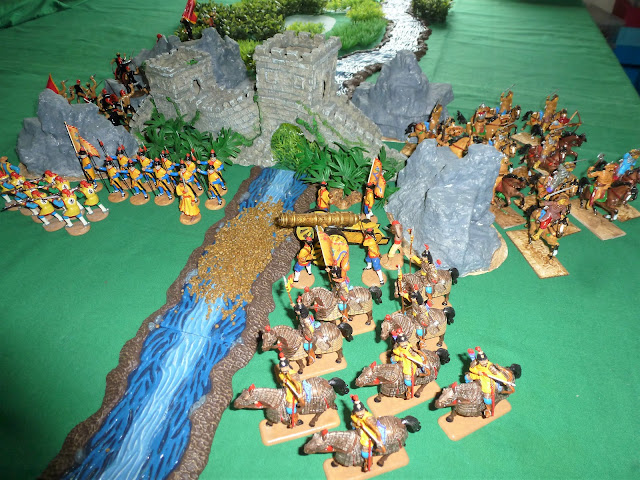Following on from the previous post, here are closeups of the second new shelf. The shelves are inside a pine wardrobe built into a chimney alcove, long since unfit for purpose but I'm averse to ripping out period features so it now houses toy soldiers and the original doors provide some protection from the dust.
When I have a little money, I buy Toy Soldiers; and if I have any left, I buy food and clothes. (with apologies to:) ERASMUS
Wednesday, 14 May 2025
Assorted Ancients now on display.
Saturday, 21 September 2024
Malcolm III and William Rufus 1093 - Battle Ravens
Since discovering that the boardgame Battle Ravens translates so well to the tabletop for a wargame with 54mm toy soldiers we thought we'd give it another outing.
Our first trial of the game was a standard shieldwall encounter between Vikings and Saxons, but the game also offers sets of cards to portray the national characteristics of Scots, Welsh and Normans so we decided to try something different.
For a scenario I chose the border raid in 1093 by the Scots of Malcolm III, in support of Saxon refugees, against a frontier outpost held by the Normans of William Rufus.
Monday, 1 April 2024
Battle Ravens - Dan Mersey
It's been a while since we last had a game but this weekend I finally managed to clear enough space for one. Battle Ravens is a board game designed by Dan Mersey with graphics provided by Peter Dennis, both well known names in the gaming world, the former for rules systems and the latter for his excellent ranges of paper soldiers. The game is about combat in a Viking/Saxon shieldwall and comes with opposing 35mm armies of Peter's card mounted paper soldiers. Anthony thought it would be good to play using 54mm toy soldiers so I dusted off the Dark Ages collection and this is how it went:
The two armies square up to form shieldwalls, each has armoured Hirdmen (Hearthguards) in the front line, unarmoured Bondi in the second line and a group of Thrals (skirmishers) behind them. The command units overseeing each shieldwall have no role in the game but I included them to represent the players, and because they look good.
Friday, 15 September 2023
Irish Warband - toy soldier conversions for wargaming
Irish sea raiders were pillaging the coast of Saxon Britain long before the Vikings arrived, they later opposed the Viking incursions into Ireland and continued fighting alongside anyone who would pay them until well after the Normans appeared on the scene. So a useful addition to any Dark Ages collection, sadly nobody ever made 54mm toys soldiers depicting Kerns or Gallowglass, so I gave them my own twist:
Saturday, 26 September 2020
Not Quite Victorious Army
But I'm sure they will be when they eventually get onto the table for a game!
For some time now I've been building up a generic Chinese army, I'm not sure why and I can't remember how it started, perhaps I just like the colours. And the flags, the flags are great. Anyway, there is no grand plan, I just bang out another unit every now and then when an idea comes to me, it's quite therapeutic, doing something different. Here's what I've got so far:






































